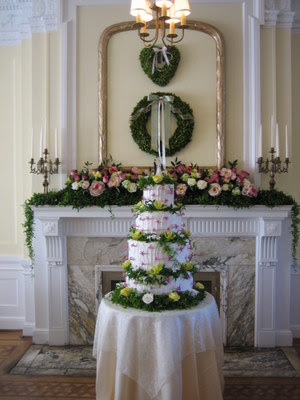
The most significant item on the Sofreh is a large central mirror, placed directly in front of where the bride and groom sit, before taking their vows. It is large enough that the bride and groom can see both of themselves in it. It also allows for all the gathered guests especially those standing behind the bride and groom to also see each other in the mirror. Aside from its practicality, the mirror represents the bright light that shines into one’s future. In our photo, you can see Orchids reflected in the mirror, which were one of two larger arrangements placed behind the Sofreh.
The mirror is flanked by two candelabras. Candles and mirrors, which are also used in the sofreh haft seen (Persian new year celebration) have are symbolistic of the Zoroastrian faith. The sun was the source of all energy and candles represent the sun and its energy.
A tray of bread also adorns the Sofreh representing prosperity. Traditionally, a flat bread called Non-e-sangak has been used and can be decorated in many ways. Representing fertility are walnuts, almonds, and or hazelnuts. These are usually painted in gold or silver colors. The sweetness of life is represented in many items including, a bowl of crystallized sugar, a small bowl of honey, and in one or more trays of assorted Persian sweets and pastry such as Baghlava, Toot, raisin cookies, and others. Additionally, behind the bride and groom, family and friends gather and hold a long scarf made of fine fabric or silk over the heads of the bride and groom. Then the guests take turns rubbing two large pieces of rock sugar (Kale-ghand) over the scarf.















